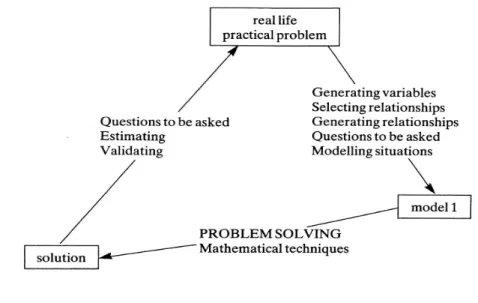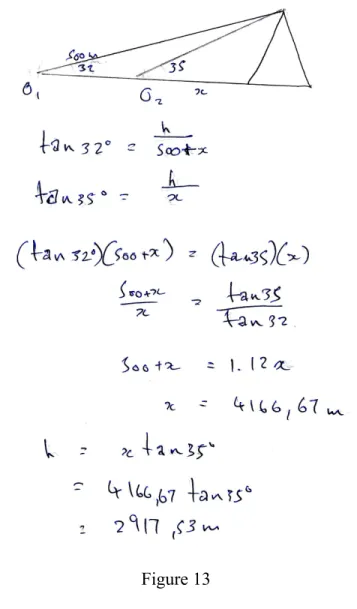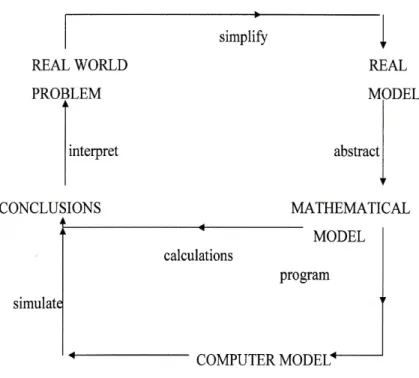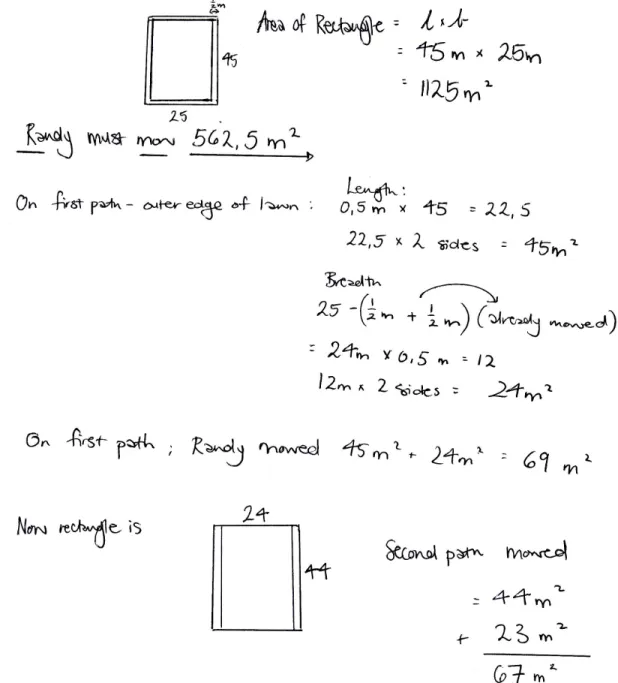This study further investigated the ability of pre-service mathematics teachers to facilitate understanding of specific mathematical modeling problems. I am grateful to the students at the University of KwaZulu-Natal (Edgewood) who participated in this study.
Introduction 1
An important aim of Mathematics in further education and training is to establish good connections between Mathematics as a discipline and the application of Mathematics in real contexts (Department of Education, 2003a). Educators are often confronted with the situation where students make no attempt to use their mathematics in real-world situations outside of school and therefore consider their school mathematics to be of little value.
Rationale for the study 4
After further investigation, the researcher found that South African based studies on pre-service mathematics teachers' conceptions and knowledge of mathematical modeling are rare. Hence the interest to try. to investigate pre-service mathematics teachers' conception and knowledge of mathematical modelling.
Organisation of the study 7
In light of the above, the purpose of this study was to explore pre-service mathematics teachers' perceptions and knowledge about mathematical modeling and the different strategies that pre-service mathematics teachers use when solving real-world mathematics problems. The researcher largely places this study within the framework of two theories, namely constructivism and realistic mathematics education in order to understand the research participants' thinking and reasoning.
Introduction 9
Fennel and Rowan (2001) advocate that using representations, whether drawings, mental images, concrete materials or equations, helps students organize their thinking and try different approaches that can lead to clearer understanding and solutions. 2002) point out that since mathematical modeling is central to understanding the real world, while simultaneously developing valid mathematics, students must be able to connect, through creative problem solving, their understanding of specific content to the modeling situation. An important consideration for the researcher in this study was whether pre-service mathematics teachers were able to facilitate students' understanding of the mathematical modeling process solution.
Explanation of terms 12
Finally, in interpreting and evaluating the solution we must check whether it is realistic by comparing it with the real world situation. It may be found that there is a need to refine the model in order to improve its predictive or descriptive capabilities, or that the model does not 'fit' the real world at all, so a new model needs to be formulated.

The need for mathematical modelling 24
Nickson (2004) argues that by using a mathematical modeling approach, teachers can identify students' thinking at different stages of reaching a problem solution, depending on the nature of the model. To justify the use of mathematical modelling, Eyre (1991) uses the following diagram to explain who might undertake such an activity and why. A) Introduction to new fields (i) Mathematics teacher.
Real-world problems and the role of contexts in the
Albert and Antos (2000) point out that when children make connections between the real world and mathematical concepts, mathematics becomes important to them, and as mathematics becomes important, students become more motivated to learn and more interested in the learning process. Furthermore, De Villiers (2007) explains that in the real world there are no perfect straight lines, flat planes and spheres, nor can measurements be made with absolute precision.
Some obstacles to the implementation of mathematical
According to Cross and Moscardini (1985), the structure of many mathematics curricula is quite formal, that is, it is precise, well structured and largely concerned with rigor. In addition, they state that there is general agreement among those involved in the teaching of mathematical modeling that it is not an appropriate vehicle for introducing new mathematical ideas and techniques.
The role of mathematical modelling in the secondary
Voskoglou (1995) also emphasizes the need for mathematical modeling in the curriculum and explains that until the late 1970s the modeling process was a tool used only by those working with applied mathematics in industry and economics. Therefore, the process of mathematical modeling is one of the introductory subjects in the mathematics lectures for the first students at the School of Administration and Economics of the Technological Educational Institute of Mesolongia in Greece.
What knowledge do teachers need to teach mathematical
A teacher must have a broad and deep understanding of the variety of approaches that students might use. Another implication for the teacher's pedagogical knowledge is highlighted in the shift that occurs in the provision of explanations and justifications.
Barriers to the implementation of mathematical modelling 37
Lingefjärd (2007) considers the rare use of the modeling process in mathematics courses as one of the obstacles to the successful implementation of mathematical modeling in the curriculum. The main aim of the course was to introduce student teachers to the practice of mathematical modelling.
Introduction 50
Constructivism 50
Within constructivism, the teacher acts as a facilitator of knowledge and must ensure that the learner has the ability to construct knowledge in their own minds through the process of discovery and problem solving. Within a constructivist teaching and learning environment, the learner should be able to make sense of a real problem in his or her own way.
Realistic Mathematics Education 55
According to Mudaly (2004), realistic mathematics teachers place great emphasis on the idea of making a mathematical idea real in the student's mind. The usefulness of the Realistic Mathematics Education approach is evident in the success achieved by the Netherlands in recent international comparisons.
Situated Learning Theory 61
In Situated Learning (n.d), Lave argues that "learning as it normally occurs is a function of the activity, context and culture in which it occurs (ie it is situated). Promote articulation to enable tacit knowledge to become clear: Articulating the vocabulary and stories of a practice culture that is an integral part of the situation presented within the learning environment deepens the student's understanding of a topic.
Introduction 64
Research questions 64
Are pre-service mathematics teachers able to facilitate the understanding of the solution of the mathematical modeling process. Do pre-service mathematics teachers possess more than one strategy for solving real-world mathematics problems.
Selection of participants 65
Do pre-service math teachers have more than one strategy for solving real-world math problems? all 21 third and fourth year trainee mathematics teachers from the Faculty of Education at the University of KwaZulu-Natal. Considering the nature of this study, these third- and fourth-year pre-service mathematics teachers provided a primary source from which the data were to be collected.
Data analysis methodology 66
Secondly, the research tasks given by the researcher to the students were considered to be within the mathematical competence of the chosen sample, following Cohen et al. 2005)'s warning to “avoid highbrow questions, even with experienced respondents”. 2005) agrees that researchers who adopt a qualitative perspective are more concerned with understanding individuals' perceptions of the world and seek insights rather than statistical perceptions of the world. Denzin and Lincoln (2003) argue that qualitative research is a situated activity that locates the researcher in the world of the participant and suggests that qualitative research involves an interpretive, naturalistic approach to the world.
Research instruments 68
The answers to these real-world problems helped the researcher answer research questions two and three of this research study. The researcher obtained permission (see Appendix E) from the participants to conduct and record the interviews.
Suitability of task-based questions 73
Randy and his sister agreed to each mow half of the lawn. If Randy starts at one corner and mows the path all the way outside, how many times would he have to go around and mow one half of the lawn.
Ensuring reliability and validity 74
Kumar (2005) defines validity as “the ability of an instrument to measure what it is designed to measure”. The researcher is of the opinion that the participants in this research study were more aware of the process of mathematical modeling after the research process.
Ethical considerations 76
Participants in this research study could not be protected from anonymity as they had to identify themselves on a task-based questionnaire. Participants must be informed about who is conducting the research and why the research participants were selected to participate.
Introduction 79
None of the participants in this research could give a precise definition of what mathematical modeling is. No lecturer has yet alerted us to the mathematical modeling aspects of NCS. Empirical evidence showed that participants did not have adequate working knowledge of the concept of mathematical modeling.

Analysis of the questionnaire 79
Analysis of the task-based questionnaire 91
Introduction 111
First I calculated the area of the entire lawn and then I calculated half the area. The net profit is equal to 25x + 30y….x and y are of course the number of tables and the number of bookcases respectively…and then I took the intersection of the two.
Summary of key findings 111
Limitations of the study 113
This research study focused on mathematical modeling in teacher education at the University of KwaZulu-Natal, South Africa. It must therefore be emphasized that the results of this research study only apply to the pre-service mathematics teachers at the University of KwaZulu-Natal, Edgewood Campus.
Recommendations for future research 113
The task-based questionnaire administered to the respondents was presented in the form of a description. A much broader and more adventurous study could investigate the implementation of mathematical modeling at the national level.
Conclusion 114
I plotted all of them on a graph and found my possible region and then I took this equation for the profit and made y the subject of the formula …….and this would be your y-. It should be a right triangle because I can easily apply my trig here……it is convenient for me and then I looked at the sum of the triangle angle = 180°…I said ok because I want angle C and this is the height.

